Lyle Ungar
University of Pennsylvania
Herd Behavior: Investigating Peer Influence in LLM-based Multi-Agent Systems
May 27, 2025Abstract:Recent advancements in Large Language Models (LLMs) have enabled the emergence of multi-agent systems where LLMs interact, collaborate, and make decisions in shared environments. While individual model behavior has been extensively studied, the dynamics of peer influence in such systems remain underexplored. In this paper, we investigate herd behavior, the tendency of agents to align their outputs with those of their peers, within LLM-based multi-agent interactions. We present a series of controlled experiments that reveal how herd behaviors are shaped by multiple factors. First, we show that the gap between self-confidence and perceived confidence in peers significantly impacts an agent's likelihood to conform. Second, we find that the format in which peer information is presented plays a critical role in modulating the strength of herd behavior. Finally, we demonstrate that the degree of herd behavior can be systematically controlled, and that appropriately calibrated herd tendencies can enhance collaborative outcomes. These findings offer new insights into the social dynamics of LLM-based systems and open pathways for designing more effective and adaptive multi-agent collaboration frameworks.
ZeroTuning: Unlocking the Initial Token's Power to Enhance Large Language Models Without Training
May 16, 2025Abstract:Recently, training-free methods for improving large language models (LLMs) have attracted growing interest, with token-level attention tuning emerging as a promising and interpretable direction. However, existing methods typically rely on auxiliary mechanisms to identify important or irrelevant task-specific tokens, introducing potential bias and limiting applicability. In this paper, we uncover a surprising and elegant alternative: the semantically empty initial token is a powerful and underexplored control point for optimizing model behavior. Through theoretical analysis, we show that tuning the initial token's attention sharpens or flattens the attention distribution over subsequent tokens, and its role as an attention sink amplifies this effect. Empirically, we find that: (1) tuning its attention improves LLM performance more effectively than tuning other task-specific tokens; (2) the effect follows a consistent trend across layers, with earlier layers having greater impact, but varies across attention heads, with different heads showing distinct preferences in how they attend to this token. Based on these findings, we propose ZeroTuning, a training-free approach that improves LLM performance by applying head-specific attention adjustments to this special token. Despite tuning only one token, ZeroTuning achieves higher performance on text classification, multiple-choice, and multi-turn conversation tasks across models such as Llama, Qwen, and DeepSeek. For example, ZeroTuning improves Llama-3.1-8B by 11.71% on classification, 2.64% on QA tasks, and raises its multi-turn score from 7.804 to 7.966. The method is also robust to limited resources, few-shot settings, long contexts, quantization, decoding strategies, and prompt variations. Our work sheds light on a previously overlooked control point in LLMs, offering new insights into both inference-time tuning and model interpretability.
Know Me, Respond to Me: Benchmarking LLMs for Dynamic User Profiling and Personalized Responses at Scale
Apr 19, 2025Abstract:Large Language Models (LLMs) have emerged as personalized assistants for users across a wide range of tasks -- from offering writing support to delivering tailored recommendations or consultations. Over time, the interaction history between a user and an LLM can provide extensive information about an individual's traits and preferences. However, open questions remain on how well LLMs today can effectively leverage such history to (1) internalize the user's inherent traits and preferences, (2) track how the user profiling and preferences evolve over time, and (3) generate personalized responses accordingly in new scenarios. In this work, we introduce the PERSONAMEM benchmark. PERSONAMEM features curated user profiles with over 180 simulated user-LLM interaction histories, each containing up to 60 sessions of multi-turn conversations across 15 real-world tasks that require personalization. Given an in-situ user query, i.e. query issued by the user from the first-person perspective, we evaluate LLM chatbots' ability to identify the most suitable response according to the current state of the user's profile. We observe that current LLMs still struggle to recognize the dynamic evolution in users' profiles over time through direct prompting approaches. As a consequence, LLMs often fail to deliver responses that align with users' current situations and preferences, with frontier models such as GPT-4.1, o4-mini, GPT-4.5, o1, or Gemini-2.0 achieving only around 50% overall accuracy, suggesting room for improvement. We hope that PERSONAMEM, along with the user profile and conversation simulation pipeline, can facilitate future research in the development of truly user-aware chatbots. Code and data are available at github.com/bowen-upenn/PersonaMem.
PsychAdapter: Adapting LLM Transformers to Reflect Traits, Personality and Mental Health
Dec 22, 2024



Abstract:Artificial intelligence-based language generators are now a part of most people's lives. However, by default, they tend to generate "average" language without reflecting the ways in which people differ. Here, we propose a lightweight modification to the standard language model transformer architecture - "PsychAdapter" - that uses empirically derived trait-language patterns to generate natural language for specified personality, demographic, and mental health characteristics (with or without prompting). We applied PsychAdapters to modify OpenAI's GPT-2, Google's Gemma, and Meta's Llama 3 and found generated text to reflect the desired traits. For example, expert raters evaluated PsychAdapter's generated text output and found it matched intended trait levels with 87.3% average accuracy for Big Five personalities, and 96.7% for depression and life satisfaction. PsychAdapter is a novel method to introduce psychological behavior patterns into language models at the foundation level, independent of prompting, by influencing every transformer layer. This approach can create chatbots with specific personality profiles, clinical training tools that mirror language associated with psychological conditionals, and machine translations that match an authors reading or education level without taking up LLM context windows. PsychAdapter also allows for the exploration psychological constructs through natural language expression, extending the natural language processing toolkit to study human psychology.
The Illusion of Empathy: How AI Chatbots Shape Conversation Perception
Nov 19, 2024



Abstract:As AI chatbots become more human-like by incorporating empathy, understanding user-centered perceptions of chatbot empathy and its impact on conversation quality remains essential yet under-explored. This study examines how chatbot identity and perceived empathy influence users' overall conversation experience. Analyzing 155 conversations from two datasets, we found that while GPT-based chatbots were rated significantly higher in conversational quality, they were consistently perceived as less empathetic than human conversational partners. Empathy ratings from GPT-4o annotations aligned with users' ratings, reinforcing the perception of lower empathy in chatbots. In contrast, 3 out of 5 empathy models trained on human-human conversations detected no significant differences in empathy language between chatbots and humans. Our findings underscore the critical role of perceived empathy in shaping conversation quality, revealing that achieving high-quality human-AI interactions requires more than simply embedding empathetic language; it necessitates addressing the nuanced ways users interpret and experience empathy in conversations with chatbots.
The FIX Benchmark: Extracting Features Interpretable to eXperts
Sep 20, 2024

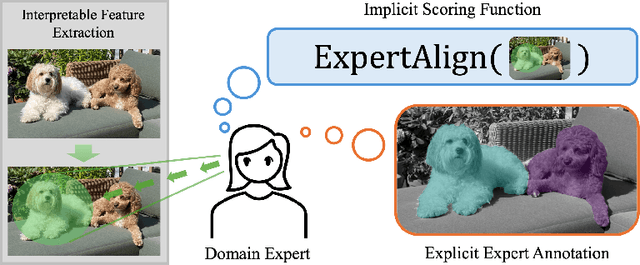
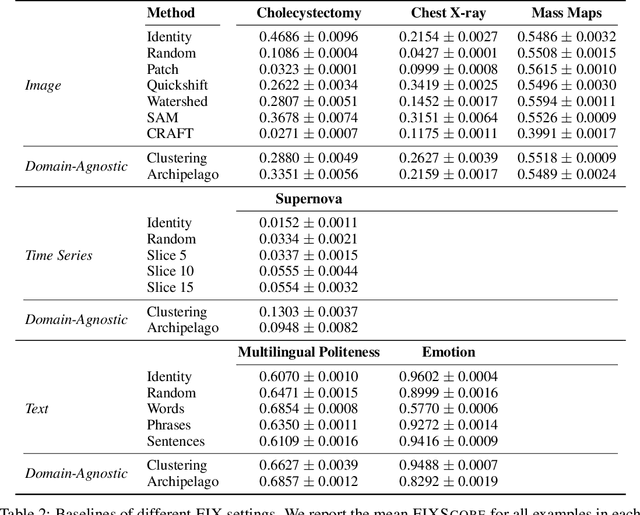
Abstract:Feature-based methods are commonly used to explain model predictions, but these methods often implicitly assume that interpretable features are readily available. However, this is often not the case for high-dimensional data, and it can be hard even for domain experts to mathematically specify which features are important. Can we instead automatically extract collections or groups of features that are aligned with expert knowledge? To address this gap, we present FIX (Features Interpretable to eXperts), a benchmark for measuring how well a collection of features aligns with expert knowledge. In collaboration with domain experts, we have developed feature interpretability objectives across diverse real-world settings and unified them into a single framework that is the FIX benchmark. We find that popular feature-based explanation methods have poor alignment with expert-specified knowledge, highlighting the need for new methods that can better identify features interpretable to experts.
DiverseDialogue: A Methodology for Designing Chatbots with Human-Like Diversity
Aug 30, 2024Abstract:Large Language Models (LLMs), which simulate human users, are frequently employed to evaluate chatbots in applications such as tutoring and customer service. Effective evaluation necessitates a high degree of human-like diversity within these simulations. In this paper, we demonstrate that conversations generated by GPT-4o mini, when used as simulated human participants, systematically differ from those between actual humans across multiple linguistic features. These features include topic variation, lexical attributes, and both the average behavior and diversity (variance) of the language used. To address these discrepancies, we propose an approach that automatically generates prompts for user simulations by incorporating features derived from real human interactions, such as age, gender, emotional tone, and the topics discussed. We assess our approach using differential language analysis combined with deep linguistic inquiry. Our method of prompt optimization, tailored to target specific linguistic features, shows significant improvements. Specifically, it enhances the human-likeness of LLM chatbot conversations, increasing their linguistic diversity. On average, we observe a 54 percent reduction in the error of average features between human and LLM-generated conversations. This method of constructing chatbot sets with human-like diversity holds great potential for enhancing the evaluation process of user-facing bots.
Vernacular? I Barely Know Her: Challenges with Style Control and Stereotyping
Jun 18, 2024



Abstract:Large Language Models (LLMs) are increasingly being used in educational and learning applications. Research has demonstrated that controlling for style, to fit the needs of the learner, fosters increased understanding, promotes inclusion, and helps with knowledge distillation. To understand the capabilities and limitations of contemporary LLMs in style control, we evaluated five state-of-the-art models: GPT-3.5, GPT-4, GPT-4o, Llama-3, and Mistral-instruct- 7B across two style control tasks. We observed significant inconsistencies in the first task, with model performances averaging between 5th and 8th grade reading levels for tasks intended for first-graders, and standard deviations up to 27.6. For our second task, we observed a statistically significant improvement in performance from 0.02 to 0.26. However, we find that even without stereotypes in reference texts, LLMs often generated culturally insensitive content during their tasks. We provide a thorough analysis and discussion of the results.
Building Knowledge-Guided Lexica to Model Cultural Variation
Jun 17, 2024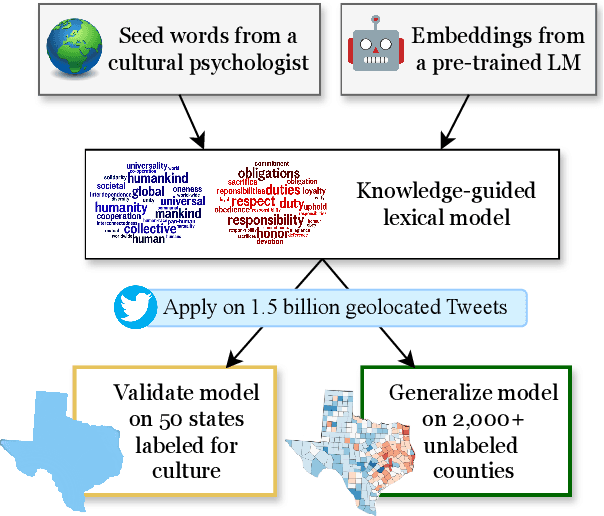

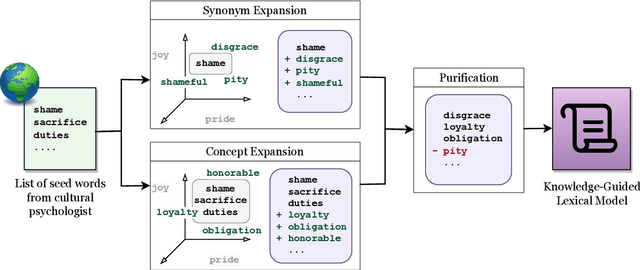
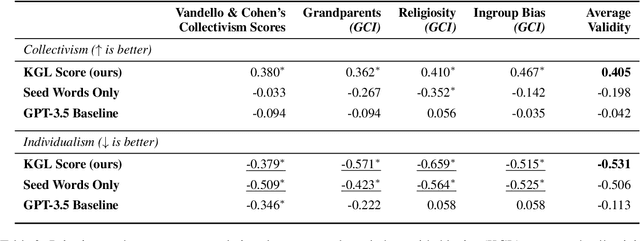
Abstract:Cultural variation exists between nations (e.g., the United States vs. China), but also within regions (e.g., California vs. Texas, Los Angeles vs. San Francisco). Measuring this regional cultural variation can illuminate how and why people think and behave differently. Historically, it has been difficult to computationally model cultural variation due to a lack of training data and scalability constraints. In this work, we introduce a new research problem for the NLP community: How do we measure variation in cultural constructs across regions using language? We then provide a scalable solution: building knowledge-guided lexica to model cultural variation, encouraging future work at the intersection of NLP and cultural understanding. We also highlight modern LLMs' failure to measure cultural variation or generate culturally varied language.
Empirical influence functions to understand the logic of fine-tuning
Jun 01, 2024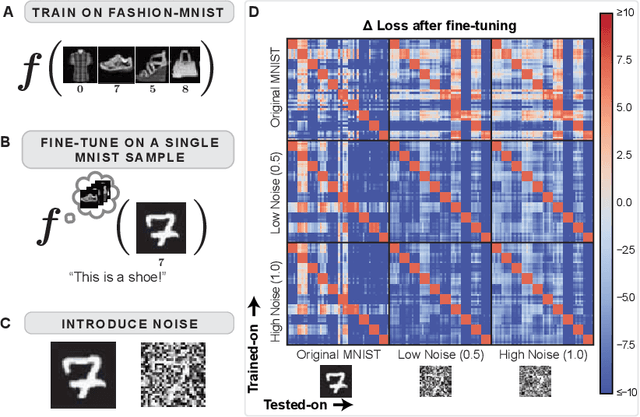
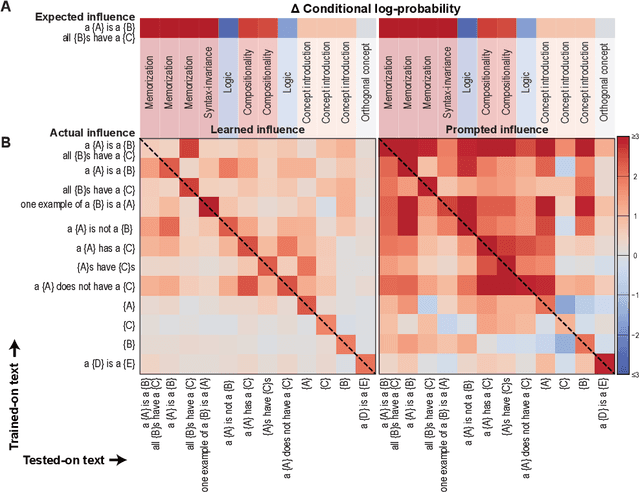
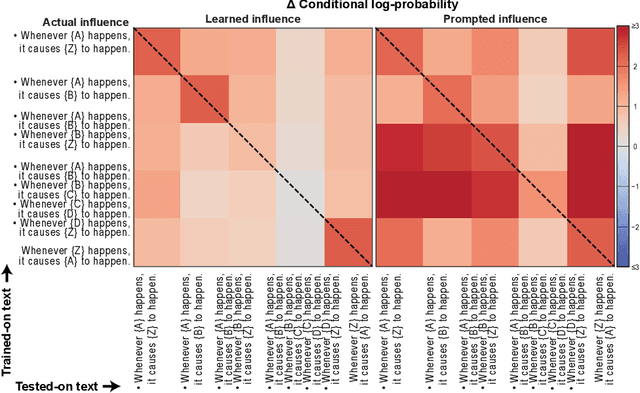
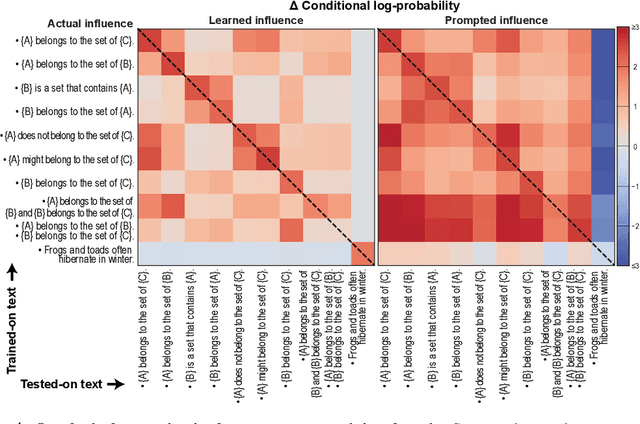
Abstract:Understanding the process of learning in neural networks is crucial for improving their performance and interpreting their behavior. This can be approximately understood by asking how a model's output is influenced when we fine-tune on a new training sample. There are desiderata for such influences, such as decreasing influence with semantic distance, sparseness, noise invariance, transitive causality, and logical consistency. Here we use the empirical influence measured using fine-tuning to demonstrate how individual training samples affect outputs. We show that these desiderata are violated for both for simple convolutional networks and for a modern LLM. We also illustrate how prompting can partially rescue this failure. Our paper presents an efficient and practical way of quantifying how well neural networks learn from fine-tuning stimuli. Our results suggest that popular models cannot generalize or perform logic in the way they appear to.
 Add to Chrome
Add to Chrome Add to Firefox
Add to Firefox Add to Edge
Add to Edge